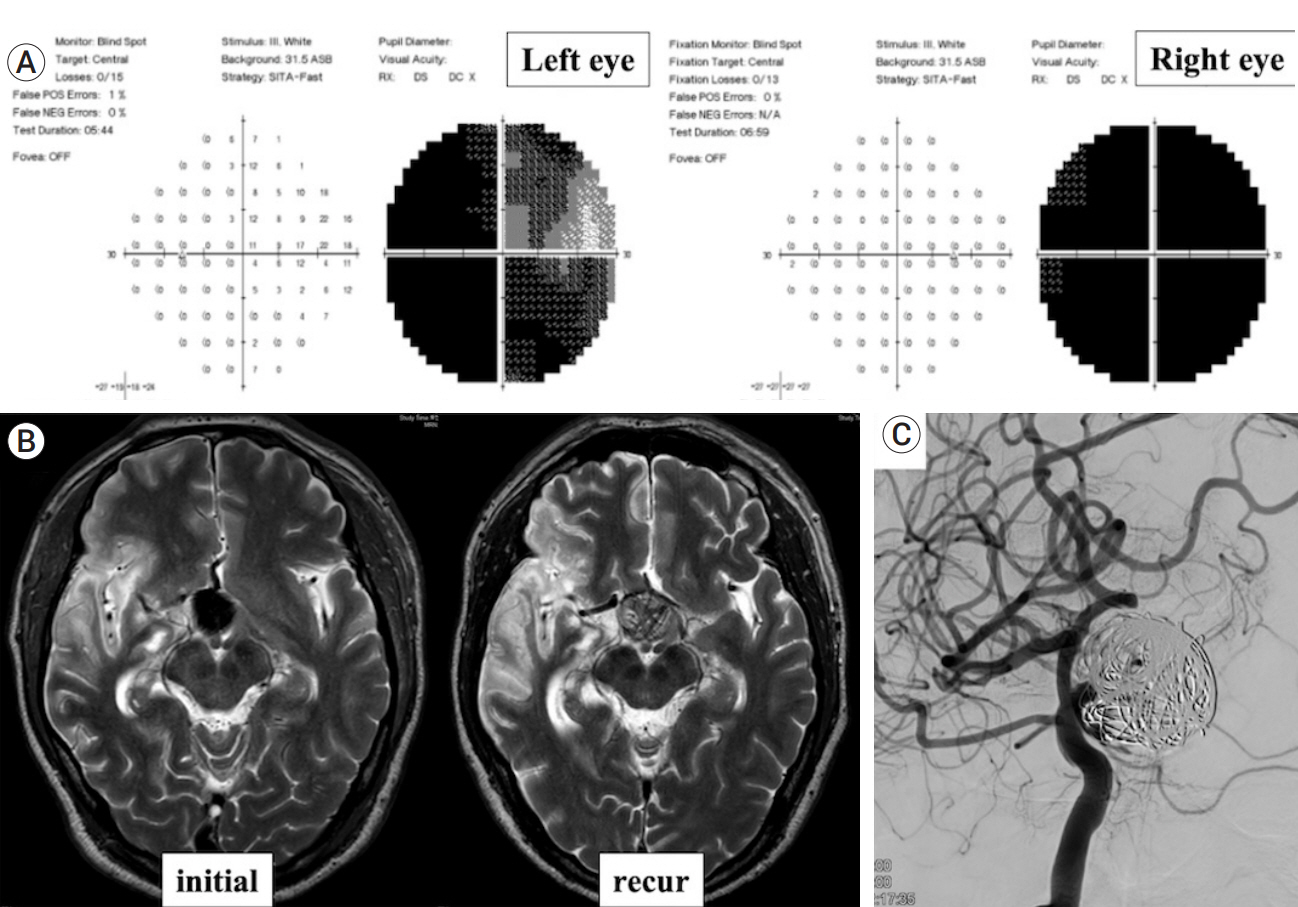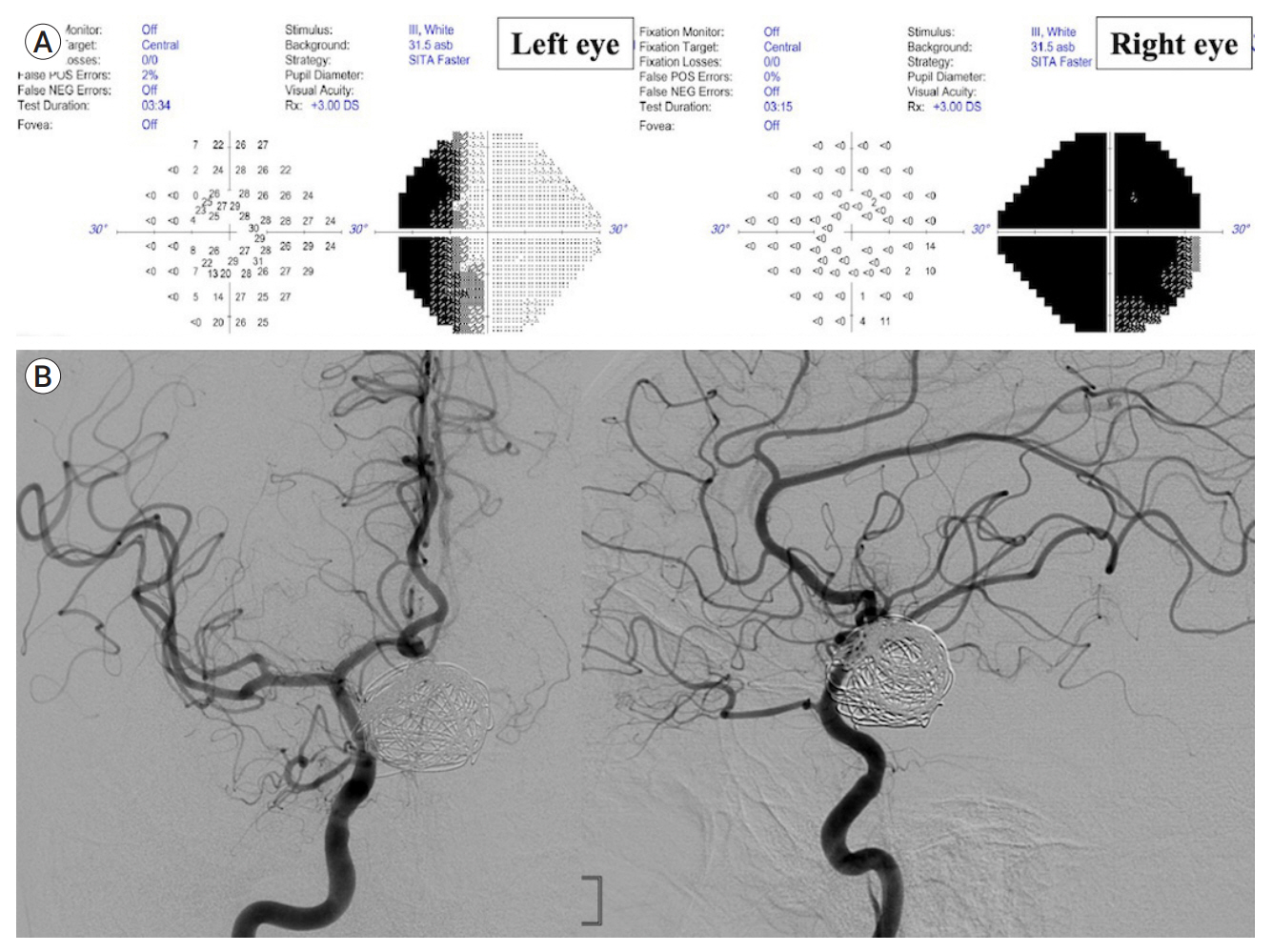J Cerebrovasc Endovasc Neurosurg.
2023 Jun;25(2):208-213. 10.7461/jcen.2022.E2022.06.007.
Retreatment of a recurrent giant aneurysm of the internal carotid artery after treatment with a flow-diverting stent
- Affiliations
-
- 1Department of Neurosurgery, Gangnam Severance Hospital, Yonsei University College of Medicine, Seoul, Korea
- KMID: 2543518
- DOI: http://doi.org/10.7461/jcen.2022.E2022.06.007
Abstract
- Flow-diverting stents (FDSs) have proven advantageous for the treatment of large, fusiform, and dissecting aneurysms that are otherwise difficult to treat. Retreatment strategies for recurrent large or giant aneurysms after FDSs are limited to overlapping implantation of an additional FDS or definitive occlusion of the parent vessel. We report a recurrent giant aneurysm that was initially treated with an FDS with coils and was successfully treated with an additional FDS. Visual symptoms due to the mass effect of the recurrent aneurysm were completely resolved, and follow-up digital subtraction angiography revealed complete obliteration of the aneurysm. Additional FDS implantation for the retreatment of incompletely occluded aneurysms after the initial FDS treatment may be feasible and safe. Further studies are required to validate these results.
Keyword
Figure
Reference
-
1. Brinjikji W, Lanzino G, Cloft H, Siddiqui A, Boccardi E, Cekirge S, et al. Risk factors for ischemic complications following pipeline embolization device treatment of intracranial aneurysms: results from the IntrePED study. Am J Neuroradiol. 2016; Sep. 37(9):1673–8.
Article2. Brinjikji W, Murad MH, Lanzino G, Cloft HJ, Kallmes DF. Endovascular treatment of intracranial aneurysms with flow diverters: a meta-analysis. Stroke. 2013; 44(2):442–7.
Article3. Carneiro A, Rane N, Küker W, Cellerini M, Corkill R, Byrne JV. Volume changes of extremely large and giant intracranial aneurysms after treatment with flow diverter stents. Neuroradiology. 2014; Jan. 56(1):51–8.
Article4. Daou B, Atallah E, Chalouhi N, Starke RM, Oliver J, Montano M, et al. Aneurysms with persistent filling after failed treatment with the pipeline embolization device. J Neurosurg. 2018; Apr. 1–7.
Article5. Fang Y-B, Lin A, Kostynskyy A, Agid R, Tymianski M, Radovanovic I, et al. Endovascular treatment of intracranial vertebrobasilar artery dissecting aneurysms: parent artery occlusion versus flow diverter. Eur J Radiol. 2018; Feb. 99:68–75.
Article6. Goertz L, Hesse N, Liebig T, Ahmad W, Abdullayev N, Krischek B, et al. Retreatment strategies for recurrent and residual aneurysms after treatment with flow-diverter devices. Neuroradiology. 2020; Aug. 62(8):1019–28.
Article7. Halbach VV, Higashida RT, Dowd CF, Barnwell SL, Fraser KW, Smith TP, et al. The efficacy of endosaccular aneurysm occlusion in alleviating neurological deficits produced by mass effect. J Neurosurg. 1994; Apr. 80(4):659–66.
Article8. King B, Vaziri S, Singla A, Fargen KM, Mocco J. Clinical and angiographic outcomes after stent-assisted coiling of cerebral aneurysms with Enterprise and Neuroform stents: a comparative analysis of the literature. J Neurointerv Surg. 2015; Dec. 7(12):905–9.9. Lv X, Yang H, Liu P, Li Y. Flow-diverter devices in the treatment of intracranial aneurysms: a meta-analysis and systematic review. Neuroradiol J. 2016; Feb. 29(1):66–71.10. Muskens IS, Hertgers O, Lycklama à Nijeholt GJ, Broekman ML, Moojen WA. Outcomes of retreatment for intracranial aneurysms—a meta-analysis. Neurosurgery. 2019; Dec. 85(6):750–61.11. Oishi H, Teranishi K, Yatomi K, Fujii T, Yamamoto M, Arai H. Flow diverter therapy using a pipeline embolization device for 100 unruptured large and giant internal carotid artery aneurysms in a single center in a Japanese population. Neurol Med Chir (Tokyo). 2018; Nov. 58(11):461.
Article12. Piotin M, Blanc R, Spelle L, Mounayer C, Piantino R, Schmidt PJ, et al. Stent-assisted coiling of intracranial aneurysms: clinical and angiographic results in 216 consecutive aneurysms. Stroke. 2010; Jan. 41(1):110–5.13. Raymond J, Guilbert F, Weill A, Georganos SA, Juravsky L, Lambert A, et al. Long-term angiographic recurrences after selective endovascular treatment of aneurysms with detachable coils. Stroke. 2003; Jun. 34(6):1398–403.14. Rouchaud A, Leclerc O, Benayoun Y, Saleme S, Camilleri Y, d’Argento F, et al. Visual outcomes with flow-diverter stents covering the ophthalmic artery for treatment of internal carotid artery aneurysms. Am J Neuroradiol. 2015; Feb. 36(2):330–6.
Article15. Shapiro M, Becske T, Nelson PK. Learning from failure: persistence of aneurysms following pipeline embolization. J Neurosurg. 2017; Feb. 126(2):578–85.
Article16. Zhu D, Yan Y, Zhao P, Duan G, Zhao R, Liu J, et al. Safety and efficacy of flow diverter treatment for blood blister–like aneurysm: a systematic review and meta-analysis. World Neurosurg. 2018; Oct. 118:e79–86.
Article
- Full Text Links
- Actions
-
Cited
- CITED
-
- Close
- Share
- Similar articles
-
- A Case of Migration of Pipeline Embolization Device Causing Rupture during Treatment of an Unruptured Vertebral Artery Dissecting Aneurysm
- Balloon Anchor Technique for Pipeline Embolization Device Deployment Across the Neck of a Giant Intracranial Aneurysm
- Kinking of Flow Diverter in a Giant Wide-Necked Supraclinoid Internal Carotid Artery Aneurysm
- Giant Aneurysm of Internal Carotid Artery: Three cases report
- Salvage flow diverter stent across the posterior communicating artery for persistent retrograde filling of a giant internal carotid artery aneurysm after parent vessel occlusion




